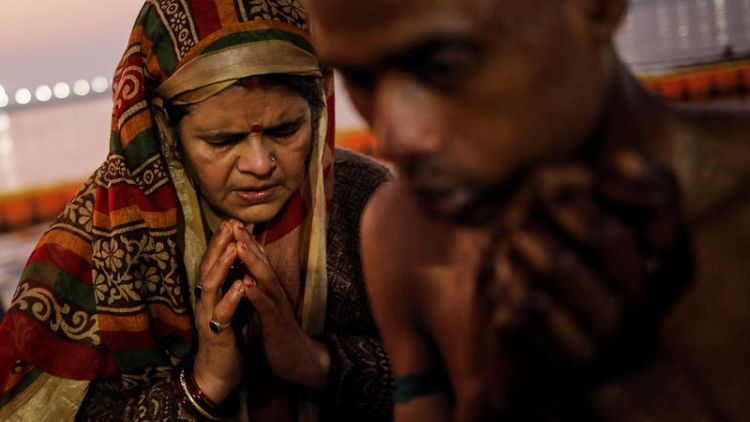By Sunil Kataria and Alasdair Pal
PRAYAGRAJ, India (Reuters) - Ash-smeared and dreadlocked Naga sadhus or Hindu ascetics, naked except for rosary beads and garlands and smoking wooden pipes, are a huge draw at the world's largest religious festival that began this week in India.
At the Kumbh Mela, or "festival of the pot", held this year in Prayagraj in north India, organisers expect up to 150 million people to bathe at the confluence of three holy rivers: the Ganges, the Yamuna and a mythical third river, the Saraswati.
The festival is one of the only opportunities to see the reclusive Naga sadhus, some of whom live in caves after taking a vow of celibacy and renouncing worldly possessions.
Their charge down to the waters to bathe at the opening of the Kumbh, many armed with tridents and swords, is one of the highlights of the festival.
"It is a confluence of all Naga sadhus at the meeting point of these holy rivers," said Anandnad Saraswati, a Naga sadhu from Mathura, a holy city in north India.
"They meet each other, they interact with each other and they meditate and pray here at the holy confluence. They give their message to the people and they transform people."
Most of the Nagas enter the orders in their early teens, leaving their friends and families to immerse themselves in meditation, yoga and religious rituals. It can take years to be conferred with the title of a Naga, they say.
"One has to live a life of celibacy for six years. After that the person is given the title of a great man and 12 years after that he is made a Naga," said Digambar Kedar Giri, a Naga sadhu from Jaipur.
During the eight-week Kumbh, generally held every three years in one of four cities in India, the Nagas live in makeshift monasteries called Akhara erected on the eastern banks of the Ganges.
They spend their days meditating, smoking cannabis and receiving a stream of visitors who come to pay their respects.
"It feels surreal: all this time you have read about them. They are almost like fictional characters and then you meet them," said a woman who gave her name as Pallavi, on a visit to the Akharas.
The Kumbh Mela has its roots in a Hindu tradition that says the god Vishnu wrested a golden pot containing the nectar of immortality from demons. In a 12-day fight for possession, four drops fell to earth, in the cities of Prayagraj, Haridwar, Ujjain and Nasik, who share the Kumbhs as a result.
(Reporting by Sunil Kataria, writing by Alasdair Pal; Editing by Sanjeev Miglani)
